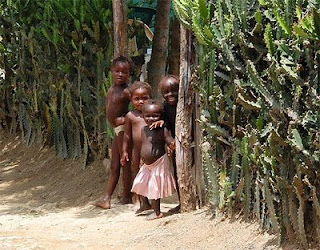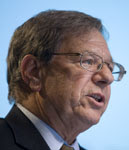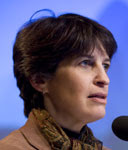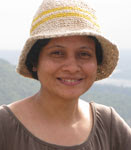-
Strength in Numbers: Can “Girl Power” Save Us From the Financial Crisis?
›July 15, 2009 // By Meaghan Parker To promote the 20th World Population Day on July 11, the United Nations Population Fund (UNFPA) tied this year’s theme—“Fight Poverty: Educate Girls”—to combating the ongoing financial crisis. It’s a no-brainer that, as UNFPA points out, “women and children in developing countries will bear the brunt of the impact.”
To promote the 20th World Population Day on July 11, the United Nations Population Fund (UNFPA) tied this year’s theme—“Fight Poverty: Educate Girls”—to combating the ongoing financial crisis. It’s a no-brainer that, as UNFPA points out, “women and children in developing countries will bear the brunt of the impact.” -
Weekly Reading
›In Search of Shelter: Mapping the Effects of Climate Change on Human Migration and Displacement, launched at the climate negotiations this week in Bonn, represents a major step forward in the effort to determine how environmental shocks and stresses precipitated by climate change will compel populations to migrate.
According to Family Planning and Economic Well-Being: New Evidence From Bangladesh, a report from the Population Reference Bureau, “long-term investment in an integrated family planning and maternal and child health (FPMCH) program contributes to improved economic security for families, households, and communities through larger incomes, greater accumulation of wealth, and higher levels of education.”
A YouTube video from the UN Office of the High Commissioner for Refugees (UNHCR) shows how Darfuri refugees are struggling to manage scarce natural resources in refugee camps in Chad.
Facing Global Environmental Change: Environmental, Human, Energy, Food, Health, and Water Security Concepts, the fourth volume of the Hexagon Series on Human and Environmental Security and Peace, was launched at a side event to the 17th Session of the Commission on Sustainable Development.
The Obama Plan for Energy and Climate Security: Conference Proceedings and Final Recommendations lays out the Center for a New American Security’s recommendations to President Obama for achieving his climate and energy goals. -
Hans Rosling Animates DHS Data, Moves Debate
›June 1, 2009 // By Brian Klein “Statistics should be the intellectual sidewalks of a society, and people should be able to build businesses and operate on the side of them,” said Gapminder Foundation Director Hans Rosling at a discussion hosted by the Wilson Center’s Environmental Change and Security Program on May 26, 2009. In his spirited and often humorous remarks, Rosling praised the 25-year-old Demographic and Health Surveys (DHS) program, which is funded by the U.S. Agency for International Development (USAID) and implemented by Macro International, Inc., as “public-private partnership at its best.” The DHS program works with countries’ health ministries to collect data on family planning, child and maternal health, disease prevalence, and other health indicators, and makes the data freely available for public use.
“Statistics should be the intellectual sidewalks of a society, and people should be able to build businesses and operate on the side of them,” said Gapminder Foundation Director Hans Rosling at a discussion hosted by the Wilson Center’s Environmental Change and Security Program on May 26, 2009. In his spirited and often humorous remarks, Rosling praised the 25-year-old Demographic and Health Surveys (DHS) program, which is funded by the U.S. Agency for International Development (USAID) and implemented by Macro International, Inc., as “public-private partnership at its best.” The DHS program works with countries’ health ministries to collect data on family planning, child and maternal health, disease prevalence, and other health indicators, and makes the data freely available for public use.
The Beauty Behind the Data
Rosling uses Gapminder’s signature “moving bubble” Trendalyzer software—which Google purchased and made available as “Motion Chart”—to graphically demonstrate global health, economic, and environmental trends. Gapminder uses data from several sources, including DHS surveys, to generate its illuminating displays.
“Sweden, during the last hundred years, didn’t achieve [the] Millennium Development Goal rate” for yearly reductions in child mortality, Rosling explained. “We are putting goals for Tanzania, Bangladesh that [were] never…achieved by any country in West Europe or North America.” The remarkable thing, said Rosling, is that many low-income countries are achieving or even surpassing these demanding targets.
Free Access, Unified Formatting Are Top Priorities
Rosling stressed that access to data must be free, and admonished the World Bank, the Organisation for Economic Co-operation and Development (OECD), and others who charge for their statistics. “They say, ‘No, we can’t give the data to the people because they will make wrong comparisons, and they will make wrong conclusions,’” Rosling continued, “and I say ‘Yes, we call it freedom.’”
Rosling cautioned against “database-hugging disorder,” or statisticians’ tendency to guard their data because of concerns about budgets or misinterpretation. A better approach, he insisted, is to embrace innovations like the Creative Commons license, which encourages sharing information by offering a range of easy-to-understand legal protections and freedoms for creative works, data, and information.
In addition, “we don’t have a unified format for data,” Rosling said, and “that’s why the transaction costs are so enormously high, and that’s why those who put data together in unified format charge for it.” He cited YouTube as an excellent medium for broadening public distribution of data. To the audience’s delight, a live Google search for “sex, money, and health” returned a YouTube clip of one of his own presentations as its top hit.
Improving Lives With Data
“The worst environmental problem today is that two million children die of diarrhea [each year], and that billions of people drink their neighbors’ lukewarm feces,” said Rosling, and yet “water and sanitation data is very, very weak.” Collecting information from remote areas—often the most impoverished—is difficult. Measuring access to potable water is complicated because it requires community-based calculations, which do not fit into DHS’ household-centric methodology.
Rosling called upon young adults to work to “eradicate unnecessary disease and poverty in the world.” He also advocated improved post-graduate training in statistics, particularly in low-income countries.
Better statistical data will foment more effective solutions to development challenges—provided there are ambassadors like Rosling willing and able to unveil the beauty behind the numbers.
Photo: Hans Rosling. Courtesy of Dave Hawxhurst and the Wilson Center.
-
Reforming Foreign Assistance: The Quest for the Holy Grail?
›May 19, 2009 // By Rachel WeisshaarThis morning, the Sustainable Security Program at the Center for American Progress released a proposal for a National Strategy for Global Development. This is only the latest in a raft of attempts to imagine a new architecture for U.S. foreign aid—several of which are reviewed in the latest Environmental Change and Security Program Report.
“Security By Other Means: Foreign Assistance, Global Poverty, and American Leadership, compiles the findings of the Brookings Institution-Center for Strategic and International Studies Task Force on Transforming Foreign Assistance in the 21st Century into a manual of sorts for reforming foreign assistance,” writes the Wilson Center’s Sean Peoples in ECSP Report 13. “Not shying away from the nitty-gritty of foreign assistance policy, the book’s contributors delve deep into the current development assistance framework and recommend valuable reforms, which include: integrating strategic security concerns; formulating clear objectives; understanding recipient country capacities; and building effective partnerships that exploit comparative advantages.”
“Trade, Aid and Security: An Agenda for Peace and Development undertakes the challenging task of assessing the interrelationships between trade and aid, as well as the complex causes of conflict within the poorest countries,” writes Wilson Center Senior Scholar John Sewell. “Several chapters in Trade, Aid and Security make the case that resources, whether derived from aid flows or legitimate trade, often are not equitably distributed or used to end poverty or promote sustainable development. Instead, they are captured by special interests or steered to political elites.” -
The Challenge for Africa: A Conversation With Wangari Maathai
›May 5, 2009 // By Rachel Weisshaar“Almost every conflict in Africa you can point at has something to do with competition over resources in an environment which has bad governance,” said Wangari Maathai, founder of the Green Belt Movement and recipient of the 2004 Nobel Peace Prize, at an April 13, 2009, event co-sponsored by the Wilson Center’s Environmental Change and Security Program and Africa Program and the International Gateway at the Ronald Reagan Building & International Trade Center. Maathai discussed her new book, The Challenge for Africa, with Environmental Change and Security Program Director Geoff Dabelko.
“This is why I wrote this book: Because I really was challenging us as Africans to think outside the box and to begin to see why when we seem to move forward, we make two steps forward, and we make one step backward, and so we look like we are not moving,” said Maathai. “Some of these issues are complex, they are difficult—but they have a lot to do with the way we have decided to manage our resources and to manage our politics and economics.”
The Three Legs of Stability
Maathai used the traditional African three-legged stool as a metaphor for what she views as the three essential components of a stable society: sustainable environmental management, democratic governance, and a culture of peace. “Those legs are chiseled by a craftsman…[who] chisels all the three legs at the same time, in order to create a balance,” she said. “If we don’t have these three legs, no matter who comes, and with whatever [loans or aid], we shall never develop.”
Land, Politics, and Ethnicity: An Explosive Combination
Maathai explained that in the absence of democratic governance and sustainable environmental management, natural resources have repeatedly ignited conflict in her native Kenya. For instance, the advent of private land ownership during colonialism pitted Maasai herders, who need large tracts of land to graze their cattle, against Kikuyu farmers, who for the first time obtained deeds to their land and began to erect fences to mark the boundaries.
In addition, Maathai noted that politicians often use Kenya’s ethnic divisions and land scarcity to whip up animosity toward internal migrants and bolster their own re-election prospects. “If you don’t, then, therefore, ensure that the resources within the country are equitably distributed, and you encourage these prejudgments that communities have against each other, you’re going to have conflict,” she said.
Holistic Approach Is Key to Successful Development
The Green Belt Movement began as a small, grassroots project that envisioned tree-planting as a way to address rural women’s needs, including firewood, food, clean water, and soil erosion. “Even though that’s how we started, it very quickly became clear to me that these are symptoms, and therefore we needed to get to the causes. And it is in search of the causes that eventually led me into understanding how interconnected these issues were,” said Maathai, who urged governments, development agencies, and nonprofits to adopt an integrated approach to development.
“Unless you deal with the cause, you are wasting your time. You can use all the money you want for all the years you want; you will not solve the problem, because you are dealing with a symptom. So we need to go outside that box and deal with development in a holistic way.”
“I can’t say, ‘Let us deal with governance this time, and don’t worry about the resources.’ Or, ‘Don’t worry about peace today, or conflicts that are going on; let us worry about management of resources.’ I saw that it was very, very important to use the tree-planting as an entry point,” explained Maathai.
“Even though it is the women who provide the drive for planting trees—partly because it is they who suffer when the environment is destroyed, it is also they who work in the field—once we are in the community, we will have to deal with the women, deal with the men, deal with the children, deal with the livestock, deal with everything,” said Maathai.
Climate Change, Forests, and Environmental Justice
According to Maathai, 20 percent of greenhouse gas emissions are due to deforestation and forest degradation—more than the percentage due to transportation. She is working with Avoided Deforestation Partners to make avoiding deforestation part of the Copenhagen agreements—a step that would not only slow global climate change, but also help those who are directly dependent on natural resources like forests for their livelihoods, and therefore most vulnerable to climate change. “This is the one issue which really comes to tell us that indeed, the planet is a small village, and all of us are in this little village together.” -
Hardship in Haiti: Family Planning and Poverty
›April 14, 2009 // By Rachel WeisshaarThe New York Times’ Nicholas Kristof aptly describes the connections between poverty and lack of access to family planning in a recent op-ed, using a Haitian woman named Nahomie as an example. He rightly argues that we won’t be able to end poverty until women are able to choose how many children to have. He also notes that relative funding levels for family planning have decreased in recent decades, and that development professionals’ attention has shifted to other issues. Yet 201 million women around the world still have an unmet need for family planning.
One of the few off notes in Kristof’s article, I think, is his portrayal of family planning as a difficult, challenging intervention. Of course, it is more complicated than simply giving birth control pills to women and condoms to men. But community health workers with little formal education have been successfully trained to deliver family-planning services to remote communities in developing countries.
While I recognize he has space limitations, Kristof neglected to mention that in Haiti, poverty and lack of access to family planning are linked to severe environmental degradation and natural disasters. A 2006 U.S. Agency for International Development (USAID) report found that “the root causes of environmental disaster in Haiti are acute poverty, rapid population growth, and unplanned urbanization.” To meet their daily needs, the rapidly growing population resorts to unsustainable agricultural and energy practices that deforest and erode the countryside—or move to increasingly crowded cities.
At a Wilson Center presentation in August 2006, USAID’s Rochelle Rainey reported that 40 percent of Haitian women wished to use contraception but did not have access to it. Modern contraceptive methods are used by only 23 percent of the population, contributing to a total fertility rate of 4.9 children per woman. As Ronald Toussaint, a Haitian biodiversity specialist, said: “If we don’t address population issues, it is like the Creole phrase, ‘wash your hands and then rub them in the dirt.’”
Photo: Children in Haiti. Courtesy of Flickr user Billtacular. -
Former USAID Population Directors Argue for Major Boost in Family Planning Funding
›April 7, 2009 // By Gib Clarke“We know how to do family planning, we know what it costs, and we know that it works,” said Joseph Speidel of the University of California, San Francisco, at the launch event for Making the Case for U.S. International Family Planning Assistance sponsored by the Wilson Center’s Environmental Change and Security Program on March 17, 2009. The key missing element, he said, is political will.
Speidel and his co-authors—all former directors of the U.S. Agency for International Development’s (USAID) Office of Population and Reproductive Health—argued that Congress should more than double spending on international family planning in the coming years for health, economic, and environmental reasons.
The Big Ask
Making the Case recommends that the USAID population budget be increased from $457 million in FY2008 to $1.2 billion in FY2010, growing further to $1.5 billion in FY2014. According to the speakers, this increase is necessary to:- Meet the “enormous pent-up and growing unmet need for family planning”;
- Stabilize population growth rates, especially in Africa; and
- Achieve the Millennium Development Goal of universal access to reproductive health services.
 Duff Gillespie of the Johns Hopkins Bloomberg School of Public Health showed that U.S. funding for family planning has been stagnant in real dollars since the late 1960s, despite the fact that there are 200 million women with an unmet need for family planning. Without champions within USAID and the Obama administration, he said, the dollar amounts appropriated for family planning are unlikely to increase.
Duff Gillespie of the Johns Hopkins Bloomberg School of Public Health showed that U.S. funding for family planning has been stagnant in real dollars since the late 1960s, despite the fact that there are 200 million women with an unmet need for family planning. Without champions within USAID and the Obama administration, he said, the dollar amounts appropriated for family planning are unlikely to increase.
Speidel explained that growing populations, combined with stable or increasing rates of consumption, contribute to climate change. The current rate of population growth is unsustainable, given Earth’s finite natural resources. Changes in behavior and technology—such as eating less meat or using clean energy—could improve environmental outcomes.
Absolute numbers still matter, however: Although population growth rates have declined, the global population continues to grow. Addressing the nearly one-half of all pregnancies that are unplanned would bring great health and environmental benefits, said Speidel. According to Steven Sinding of the Guttmacher Institute, although most economists and demographers agree that economic growth leads to lower fertility, whether lower fertility reduces poverty is still a matter of much debate. But the “demographic dividend” generated by slowing population growth is a reality, he argued, and countries can benefit from it if their institutions are prepared to take advantage of it. For example, a USAID study found that one dollar invested in family planning in Zambia saved four dollars in other development areas.
According to Steven Sinding of the Guttmacher Institute, although most economists and demographers agree that economic growth leads to lower fertility, whether lower fertility reduces poverty is still a matter of much debate. But the “demographic dividend” generated by slowing population growth is a reality, he argued, and countries can benefit from it if their institutions are prepared to take advantage of it. For example, a USAID study found that one dollar invested in family planning in Zambia saved four dollars in other development areas.
A Broader Base of Support Ruth Levine of the Center for Global Development urged the authors to avoid “preaching to the choir.” One way to engage other constituencies interested in demographic issues is to broaden the scope of “population” to include not only family planning, but also migration, urbanization, and other key demographic issues.
Ruth Levine of the Center for Global Development urged the authors to avoid “preaching to the choir.” One way to engage other constituencies interested in demographic issues is to broaden the scope of “population” to include not only family planning, but also migration, urbanization, and other key demographic issues.
In addition, convincing World Bank economists, especially the Bank’s next president, of the connections between declining fertility and poverty reduction should be a priority, said Levine, because developing countries put a lot of stock in the Bank’s advice.
By Gib Clarke
Edited by Rachel Weisshaar
Photos: From top to bottom, Joseph Speidel, Duff Gillespie, Steven Sinding, and Ruth Levine. Courtesy of Dave Hawxhurst and the Wilson Center. -
PODCAST – Forests for the Future: Family Planning in Nepal’s Terai Arc Landscape
›April 3, 2009 // By Wilson Center Staff“The Terai Arc Landscape has a very high population growth rate; people are very much dependent on the natural resources,” says Sabita Thapa in this podcast from the Environmental Change and Security Program.“We are especially working through the population, health, and environment project to address the issues of forest conversion, forest encroachment, and fuel extraction,” explains Thapa
 .
. In this podcast, Thapa, now an environmental advisor with the United Nations Development Programme in the Solomon Islands, and Dhan Rai, senior project manager with World Wildlife Fund-Nepal, discuss WWF’s PHE program in Nepal’s Terai region.
To learn more about PHE in Nepal, read FOCUS Issue 18, “Forests for the Future: Family Planning in Nepal’s Terai Region.”
And for additional resources, please visit our PHE webpage.
Photo: Sabita Thapa. Courtesy of Meaghan Parker.
Showing posts from category poverty.


 To promote the 20th World Population Day on July 11, the United Nations Population Fund (UNFPA) tied this year’s theme—
To promote the 20th World Population Day on July 11, the United Nations Population Fund (UNFPA) tied this year’s theme— “Statistics should be the intellectual sidewalks of a society, and people should be able to build businesses and operate on the side of them,” said
“Statistics should be the intellectual sidewalks of a society, and people should be able to build businesses and operate on the side of them,” said 

 Duff Gillespie of the Johns Hopkins Bloomberg School of Public Health showed that U.S. funding for family planning has been stagnant in real dollars since the late 1960s, despite the fact that there are 200 million women with an unmet need for family planning. Without champions within USAID and the Obama administration, he said, the dollar amounts appropriated for family planning are unlikely to increase.
Duff Gillespie of the Johns Hopkins Bloomberg School of Public Health showed that U.S. funding for family planning has been stagnant in real dollars since the late 1960s, despite the fact that there are 200 million women with an unmet need for family planning. Without champions within USAID and the Obama administration, he said, the dollar amounts appropriated for family planning are unlikely to increase. According to Steven Sinding of the Guttmacher Institute, although most economists and demographers agree that economic growth leads to lower fertility,
According to Steven Sinding of the Guttmacher Institute, although most economists and demographers agree that economic growth leads to lower fertility,  Ruth Levine of the Center for Global Development urged the authors to avoid “preaching to the choir.” One way to engage other constituencies interested in demographic issues is to broaden the scope of “population” to include not only family planning, but also
Ruth Levine of the Center for Global Development urged the authors to avoid “preaching to the choir.” One way to engage other constituencies interested in demographic issues is to broaden the scope of “population” to include not only family planning, but also  .
. 

